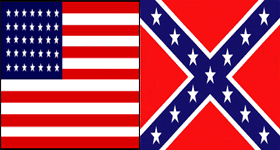 |
Civil War Battles |
|
State War Records |
| AL - AK - AZ - AR - CA - CO - CT - DE - FL - GA - HI - ID - IL - IN - IA - KS - KY - LA - MA - MD - ME - MI - MN - MS - MO - MT - NE - NV - NH - NJ - NM - NY - NC - ND - OH - OK - OR - PA - RI - SC - SD - TN - TX - UT - VT - VA - WA - WV - WI - WY |
The Battle of Rowlett's Station/Green River
December 17, 1861 in Rowlett's Station, Kentucky
 |
|||||||||||||||||||||
|
After Brig. Gen. Don Carlos Buell took command of the Department of the Ohio in early November, he attempted to consolidate control by organizing and sending troops into the field. He ordered Brig. Gen. Alexander McCook, commanding the 2nd Division, to Nolin, Kentucky. In the meantime, the Confederates had established a defensive line along the Green River near Munfordville. McCook launched a movement towards the enemy lines on December 10, which the Confederates countered by partially destroying the Louisville & Nashville Railroad bridge over the Green River.
As a result, the Union sent 2 companies of the 32nd Indiana Volunteer Infantry Regiment across the river to prevent a surprise and began constructing a pontoon bridge for the passage of trains and artillery. When the bridge was completed on December 17, 4 more of the 32nd Indiana companies crossed the river. The combined force advanced to a hill south of Woodsonville where, in the afternoon, they spotted Confederate troops in the woods fronting them. Two companies advanced toward the enemy in the woods, which fell back until Confederate cavalry attacked.
A general engagement ensued as 8 Union companies fought a much larger Confederate force. Fearing that the enemy might roll up his right flank, Col. August Willich, commanding the regiment, ordered a withdrawal to a stronger position in the rear. Knowing of McCook's approach, the Confederates also withdrew from the field.
Although the results of the battle were indecisive, Union troops did occupy the area and insured the movement of their men and supplies on the Louisville & Nashville Railroad.
Both sides claimed victory, attributing grievous losses to each other. While the outcome was indecisive, the Union forces remained in control of the field of engagement, incidentally making recovery of casualties, and the accounting of those lost, wounded, or missing difficult. The forces continued to ensure the movement of Union men and supplies on the Louisville and Nashville Railroad.
The 32nd gained nationwide recognition for its stand against Confederate forces at Rowlett's Station, Ky. A detachment of 500 men under Lt. Col. Henry von Trebra fought off 1300 men of Terry's Texas Rangers and infantry under General Hindman. The 32nd formed the "hollow square", and drove the attackers back, losing 10 and 22 wounded, but killing thirty-three of the enemy, including Col. Terry and wounding fifty others.
Twelve men of the 32nd Indiana Regiment were originally buried on a hilltop near the battle site. In 1867, the state of Kentucky transferred the remains, as well as the limestone tablet bearing an inscription in the soldiers' honor in German, to Cave Hill National Cemetery in Louisville, Kentucky. The stone monument is the oldest Civil War monument in the United States.
The 8th Texas Cavalry Regiment changed its name to "Terry's Texas Rangers" in honor of the fallen Colonel.
The Battle of Rowlett's Station was soon overshadowed by Union victories at Mill Springs, Kentucky, and Fort Henry and Fort Donelson, Tennessee.
